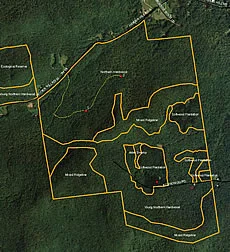by Bruce MacPherson
Tucked away near the eastern border of Hinesburg is an 840 acre tract of public land known as the Hinesburg Town Forest. In July, 2008, Aaron Worthley evaluated this property on behalf of Audubon Vermont and wrote a report entitled “Forest Bird Habitat Assessment and Management Recommendations”. This report represents an excellent example of Audubon Vermont’s major conservation effort known as the Forest Bird Initiative. Working with private landowners and conservation committees in Vermont’s towns, wildlife biologists from Audubon Vermont assess the suitability of the available habitat to support birds and other wildlife, especially so-called responsibility birds, and offer management recommendations for improving or sustaining this habitat for birds. An important aspect of this evaluation is to confirm that the birds predicted to occupy the property are actually present. That’s where GMAS volunteers come in.
At the request of Steve Hagenbuch from Audubon Vermont, Bill Mercia organized a group of volunteers who visited the Hinesburg Town Forest on two occasions during the breeding season in June, performing area counts of the birds that were seen and heard at four selected points in the forest. This is an account of one of those monitoring walks.
We meet in the parking area near Hayden Hill Road West and walk to the first of the two points that Steve has selected for us. The weather is mild, 61 degrees, and cloudy with a threat of rain. Good weather for birding. This parcel of land consists mainly of Northern Hardwood Forest, especially sugar maple, white ash and beech trees. However, a patch of this forest has been recently harvested. We will evaluate points in both the disturbed and the undisturbed areas. Naturally, we will identify all of the birds that we hear or see, although the focus is on responsibility birds. At point 1, the harvested area, Ali Wagner hears and identifies the first bird as usual, an Ovenbird. In quick succession Bill Mercia and Mae Mayville identify a Black-throated Blue Warbler, a Blue-headed Vireo, and a Black-throated Green Warbler-all responsibility birds. We are off to a good start. Bill Mayville spots another Ovenbird flitting around in the brush. Possibly there is a nesting pair. Bill Mercia picks out the song of a Mourning Warbler, an excellent discovery. I identify a Blue Jay.
After 30 minutes of watching and listening we move on to point 2 a few hundred yards down the trail. This area is undisturbed forest. Still we hear birds. First we hear a Yellow-bellied Sapsucker’s beat, trailing, off at the end. Then another Blue Jay jeering at us. Next we hear the flutey song of a Wood Thrush in the distance. Cool. Shirley Johnson finds a Black-and-White Warbler inching out on a branch above us. Shirley always finds Black-and-white Warblers when I can’t. Chip Wright points out a Downy Woodpecker that is tapping on a dead snag nearby. Nice. Ovenbirds seem to be everywhere. And both Red-eyed and Blue-headed Vireos call from above. Without acute hearing these birds probably would have been missed. After 30 minutes we have heard and seen enough. It is time to move on to points 3 and 4. But wait. A Broad-winged Hawk is circling overhead. Not a responsibility bird, but a welcome sighting nonetheless. No wonder the woods became so noisy when we walked out.
Steve’s monitoring protocol states that we only need to spend 6 minutes at each point to count the birds adequately, but we enjoy spending time in the forest and allow ourselves to dally. The next points are located on the opposite side of the Hinesburg Town Forest near the entrance at Economou Road. Here the habitat changes again. Point 3 is a softwood plantation composed of white pine, red pine, and Norway spruce. Here we expect to find Pine Warbler, Blackburnian Warbler, and Dark-eyed Juncos and we do! In fact, juncos are chattering everywhere. We hear, an Eastern Wood-Pewee in the distance as well as more vireos. Alison hears a Yellow-rumped Warbler, but I’m not sure. She’s probably right. Carl Runge spots still another Ovenbird as well as a White-breasted Nuthatch. Enough. We move on to point 4.
Point 4 consists of a stand of young Northern Hardwoods. Immediately, we hear the songs of Black-throated Green and Black-throated Blue Warblers. At the very top of a tall sugar maple Bill Mercia identifies a handsome male Baltimore Oriole. Otherwise, the woods are getting quieter as the morning progresses. A Veery, a Wood Thrush, and a few vireos fill out the list. We are done for today. But we will return here in two weeks to repeat this walk. We are coming to the end of the breeding season, so we expect that the woods will be quieter the next time that we do our point counts. In the meantime the data will be entered into the Vermont eBird database and sent to Steve. He will compare our observations with his predictions and will follow the results that we obtain in the managed areas as the early successional forest matures. We look forward to participating in the Forest Bird Initiative next year and for many years to come.
The aerial map of the Hinesburg Town Forest showing habitat sections and count points is provided courtesy of Steve Hagenbuch.
